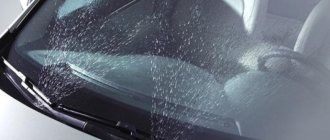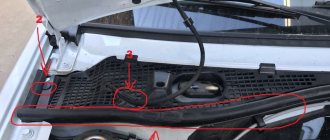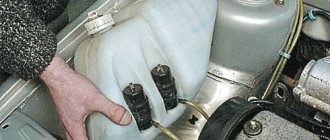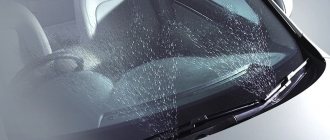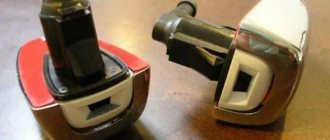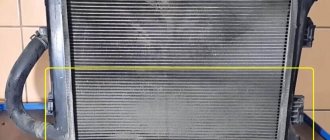Hello again, my readers, today I decided to write about the brake fluid reservoir, an important part in the brake system. It stores a supply of fluid, which ensures that the brakes operate during braking without air getting into the system. Thanks to the lid, it also prevents moisture and debris from entering the liquid. If you do not make sure that there is enough fluid in it, then at the decisive moment you can be left without brakes. The level of brake fluid in the reservoir helps to identify a leak in the brake circuit; if it begins to drop sharply, you just need to monitor it periodically.
Where is he located
Where is this part located? It is located in the engine compartment under the hood; you just need to open it. Usually it is noticeable immediately, and it is not difficult to reach it with your hand. When operating vehicles, you need to monitor the level and add brake fluid to the reservoir. However, now there are cars where you cannot see the location of the tank. It is hidden deep in the compartment and covered with a decorative panel or parts.
Then, to find it, you need to consult the car manual or the Internet.
How to remove it
Remove the brake fluid reservoir to replace it or clean it from sediment and dirt. Sometimes this is done to change the rubber bushings that secure it. The sequence is:
- The tank lid is removed. Under it there is a float from a sensor that monitors the liquid level;
- It is better to carefully place the cork on a clean rag, because liquid drips from the float and you can get dirty;
- Taking a rubber bulb or a simple medical syringe with a larger volume and a jar where you will collect the liquid, pump out the liquid from the tank to the maximum;
- After this, press the tank latches on the sides, pry it up (with a screwdriver) and remove the tank from the cylinder;
- After such an operation, the rubber bushings of the tank must be replaced.
- Therefore, we pry up and remove the bushings from the holes of the cylinder.
- Now the tank is washed and, if necessary, replaced.
- Before installing the tank in its place, you need to insert new bushings: only after this can you insert the tank into the bushings all the way by hand.
- To make the job easier, wet the bushings with brake fluid before inserting the reservoir.
- After installing the reservoir in place, you need to fill it with liquid, and then bleed the entire brake system.
Here's how to change this part, now let's look at cleaning options.
Purpose of the container
The design of the domestic VAZ 2107 car uses a hydraulic braking system, consisting of drive and actuator mechanisms, as well as lines in the form of tubes and hoses, and a reservoir filled with liquid. This liquid substance acts as a drive source, and it is called brake fluid - an acid that is hygroscopic. It is poured into a transparent plastic container under the hood, but more on that.
The container in question on the seven is made of soft and impact-resistant plastic. It is almost impossible to break the tank, but it is easy to damage it with a sharp tool. The reservoir is filled with fluid, which goes to the master cylinder. The piston moves in the cylinder when the middle pedal is pressed, thereby increasing the pressure in the system. When the pressure increases, the working cylinders are activated, in which the pistons move under the action of a liquid substance.
From a brief description of the principle of operation of the brake system on the VAZ 2107, it is clear that the reservoir plays a fundamental role. It ensures an uninterrupted supply of working substance to the main cylinder of the system. If lines or operating mechanisms are damaged, the tightness of the system is compromised. Due to the fact that the tank has transparent walls, it is possible to identify system malfunctions easily and quickly. To do this, you need to open the hood and look to see if the container is full.
How to change the tank
Before replacing the brake fluid reservoir, you need to understand its location. The reservoir is located on the driver's side under the hood. When you open the hood, you need to look at the wall closest to the cabin, where there will be two plastic tanks next to each other. The first reservoir, which is located to the left, is a container for brake fluid. Next to this tank there is another tank of a smaller volume - this is a container for a similar substance, which is used in the clutch system.
Vehicle owners should be aware that brake fluid must be replaced every 40 thousand km. If the car has mileage above this indicator, then the quality of the mixture deteriorates, which can cause brake failure at any time. In addition to replacing the mixture every 40,000 km, it is also necessary to periodically monitor the level of brake fluid in the reservoir and, if necessary, top it up.
Cleaning the tank
Inside the tank, over time, plaque and sediment inevitably appears on the walls due to the decomposition of the rubber elements of the system during operation, and the smallest chips arising from the friction of the working parts. This is why the brake fluid in the clutch reservoir darkens. Fresh fluid will become contaminated.
It is better to get rid of it in a timely manner so that the system does not clog.
Here are the cleaning methods:
- The most popular method has become to remove dirt in the tank using carburetor flushing fluid. It dissolves almost any contaminant and works great here. The disadvantages include the difficulty of accessing the internal walls and the fact that such a tool is not always available at hand.
- Another method is water pressure under high pressure. It also does a good job of sweeping away sediment and plaque that flows out of the tank, or rather flies out with the water. The disadvantage of this method is that strong pressure can damage the body if the Karcher is poorly adjusted.
- The third not bad way to clean the tank is to pour detergent or sand into it. The action of abrasive powder removes black dirt and plaque well. The disadvantage of this method is that it is not suitable for tanks in which the mesh is tightly installed.
- You can also wash it with gasoline, it dissolves deposits quite well. At the same time, it is at hand for motorists.
Design and principle of operation
Modern expansion tanks for cars are a reservoir made of durable thick-walled plastic with a filler neck and fittings for connection to the elements of the cooling system. The shape of the tank does not matter functionally, so manufacturers customize it to fit the location of the tank.
The shape of the tank depends on the location of its installation and can be different - round, rectangular or flat
The capacity of the container for expanding antifreeze is calculated for each car model and depends on the total volume of liquid in the pipes and units. Moreover, in a cold state, the tank is only half filled with antifreeze, the rest of the space is occupied by air that can compress under pressure. The neck of the tank is closed with a plug with a built-in air valve. The principle of operation of the container is as follows:
- When the engine is “cold,” the tank is half empty—the antifreeze level is between the minimum and maximum marks on the body.
- After starting the engine, the antifreeze begins to expand and its level in the vessel rises, and the air gap contracts. The lid valve remains sealed.
- When the liquid reaches an operating temperature of 90–95 °C and a maximum increase in volume, the pressure in the tank reaches the air valve response threshold (1–1.2 Bar or 120 kPa). It opens and releases air into the atmosphere.
- As the engine cools down, the opposite picture is observed - the valve allows air to flow in the opposite direction until the amount of antifreeze stops decreasing. This prevents air locks in hoses and radiators.
The design of the container is quite simple - the tank body is closed with a stopper with a built-in valve
In an emergency situation, when antifreeze or water begins to boil for various reasons, the safety valve releases not only air, but also steam.
In some car models, for example, VAZ 2110-2115, the container is equipped with a second neck into which the coolant level sensor is screwed. If, due to a breakdown or leakage of a component, antifreeze begins to leak out and its level in the container drops to a minimum, the sensor will operate and warn the driver with a signal from the corresponding light on the instrument panel.
There are cars (both domestically produced and imported) in which the expansion tank is closed with a simple plug, not equipped with a valve and communicating with the atmosphere. In such systems, the function of releasing pressure and re-injecting air is performed by the main radiator cap, and the reservoir only compensates for the expansion of the liquid.
The radiator cap is equipped with a bypass valve that directs excess antifreeze into the expansion tank
Why change the fluid?
Why do you need to change the fluid at all? Remember that regardless of the duration of action, the liquid must be changed periodically. This must be indicated in the operational documents; each brand and model has individual characteristics. You'd better check the manual. As a rule, the brake fluid replacement period is 30-40 thousand times, or once every 2-3 years.
To dispel misconceptions about brake fluids, I will say that they are not designed to last the entire service life of the car, just like the oil in the box or engine. During operation, it gradually loses its properties, the additives in it are destroyed, it absorbs moisture from the air and becomes contaminated with rubber from abrasion of the cuffs and shavings from rubbing parts. The quality of the fluid decreases and as a result the brakes may fail.
Mixing liquids is not advisable, even if it is allowed by the manufacturers. Therefore, partial replacement of the brake fluid in the reservoir is acceptable for a short period and in extreme cases, it is generally better to replace the brake fluid in the system completely.
It is also a misconception that any DOT-4 standard liquid can be used in cars. You must adhere to the manufacturer's requirements, so use the liquid prescribed in the instructions. There is no point in discussing the advantages or disadvantages of different liquids when choosing the best one for yourself, just follow the requirements of the specialists who have already calculated and verified everything for you; for your safety, you just need to follow their instructions.
We are finalizing the VAZ 2109 washer Crafts for cars
Good afternoon. I would like to share an idea for upgrading the windshield washer on 9. The point is to install a second motor and get rid of the washer solenoid valves (which are now very difficult to find on sale, because they were installed on the very first Samaras with an old-style reservoir that had a remote pump).
What we need to have:
1) Two motors (I always buy from VAZ 2110, because they are more powerful (2.5 Atm versus the standard 2108 1.6 Atm), I advise you to buy from PRAMO, because in addition to the pump itself, the kit includes a landing sleeve and a small mesh filter for cleaning).
160r/piece
right
completeness
filterik
2) A new type tank for 2 pumps (there are ready-made ones with 2 holes on sale, but you can make a second one without any problems if the tank has a seat for a second pump, as in my case).
new
3) Carburetor check valve 2108. It is needed so that the washer fluid is constantly in the pipeline, and when the pump is turned on, it immediately hits the glass in front of the wiper, and not after it passes through the dry glass.
4) Washer hose, very short length, ~10 cm. Needed to connect the pump with a check valve.
Now let's get started:
1) Make a hole for the second pump.
cut with a knife
2) Place rubber bushings on the silicone sealant.
ABRO black
3) We install the pumps ourselves.
4) And we connect according to the following scheme: To the first pump (which is closer to the headlight) we connect a tube from the rear glass washer + a check valve with a piece of hose. And to the second pump there is a windshield washer hose. Why in this order? Yes, because when the washer fluid freezes, the second pump, which is located closer to the engine, will warm up faster, because the front washer is more needed.
Next, we connect the wires to the pumps: Black wires (double) to the “-” pumps. We connect the pink wire to the “+” terminal of the windshield pump (previously this wire was located on the front window valve). Then we connect the pink wire with a black stripe to the “+” of the rear window pump. We isolate the remaining two wires (pink with a white stripe and the third black).
For better atomization, you can also install two-jet washer nozzles or fan nozzles from the VAZ 2110.
Why is the level decreasing?
There are several reasons why brake fluid left the reservoir:
- He himself became thin and cracked;
- The bushings under the tank are leaky;
- One of the wheel cylinders, the line or the main cylinder is leaking;
- Natural evaporation and consumption during operation, only this happens slowly, topping up is usually at the next maintenance, and not more often. And if you don’t need to top it up between maintenance, then that’s normal;
- The brake fluid was squeezed out of the reservoir due to too much of it, or a poorly screwed cap. Externally, the tank will be dirty and dusty with streaks;
That's why the fluid leaves. It still takes a lot to pump the system, and the level may drop slightly after pumping on the first day, this is normal.
How to check the fluid
To check the quality of TJ there are special testers, of which there are many on the market today. Before purchasing, you should study the instructions to understand what can be tested using this device. We need a boiling point, according to which a conclusion about its suitability will be drawn:
- If the temperature exceeds 175 degrees, the fluid is in good condition;
- If it is 165-175, provided that no more than two years have passed since the date of filling the liquid, it is suitable;
- When it boils at 165 degrees or lower, it needs to be replaced completely;
Video with a solution to this problem
Changing the fluid yourself
Before opening the tank itself, wipe the outside of the tank with a rag to prevent debris from getting inside. Make sure that the brake pedal is not depressed when you open the lid (liquid may splash out). It is recommended to work with rubber gloves, because the liquid is toxic. Hands should be washed with soap afterward.
When you add fuel fluid, make sure that its level is between the minimum and the upper mark. When performing a complete replacement, the fluid is drained from all circuits and then I pump the entire system again, starting with the most distant wheel (where the longest tube goes to the brake cylinder). If the contours are located diagonally, then the right rear wheel begins to pump. Then left in front. Then, accordingly, the left one is behind and finish on the right one in front.
If the contours are parallel, then pump the rear on the right, then on the left, then the front on the right and left. The video shows the process of replacing the tank itself. It is more convenient to perform pumping in a hole or by rolling the car onto an overpass. The tools and fluid here will depend on the make of your car.
Upon completion of pumping, you should slow down several times at low speed; if any wheel reacts weakly, which is felt by the car being pulled to the side, pump it again. After the first trip, you should check the brake fluid level again; most likely you will have to add more.
That's all, share the link with your friends, as usual, and subscribe to the site if you haven't already. I look forward to your feedback and comments, see you soon
Let's sum it up
As we were able to tell you, the expansion tank is found on almost all types of cars. Its reliability directly depends on operating conditions and temperature changes and the condition of the valve inside the lid. Do not pour refrigerant into a heated reservoir, otherwise you may damage the integrity of the entire system.
The cooling system of a modern car includes several elements, without which its normal functioning is impossible. These include an expansion tank, installed in different places under the hood depending on the make of the car. A simple plastic reservoir with a plug plays an important role in the operation of the engine cooling circuit and requires periodic monitoring by the car owner.
